#cuban solenodon
Text
Lesser known small mammals (or mammals whenever i bring up people have no idea what im talking about)

Quoll ..a carnivorous marsupial native to Australia that spends most of the day sleeping in its dens. there have been 111 recorded events of quolls eating human remains (x) (pictured here is a spotted-tail quoll)

Numbat..an insectivorous marsupial from Australia that is diurnal (or is primarily active during the day). unlike other mammals that primarily eat termites, they have a jaw with 50 very small teeth. they live in tree hollows and block the openings with the thick hide of their rump

Hyrax ..a small thickset herbivorous mammal that is more closely related to elephants and sea cows than pikas and marmots. theyre found in africa, and they have rubbery paw pads that help them climb up rocks (this is a rock hyrax)
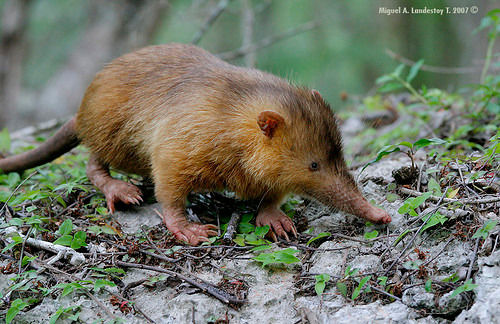
Solenodon... a venomous, insectivorous little mammal that is easily provoked into a frenzy of squeaking and biting. it uses echolocation to compensate for its poor eyesight, and females have two teats almost located on its backside (above is a cuban solenodon)
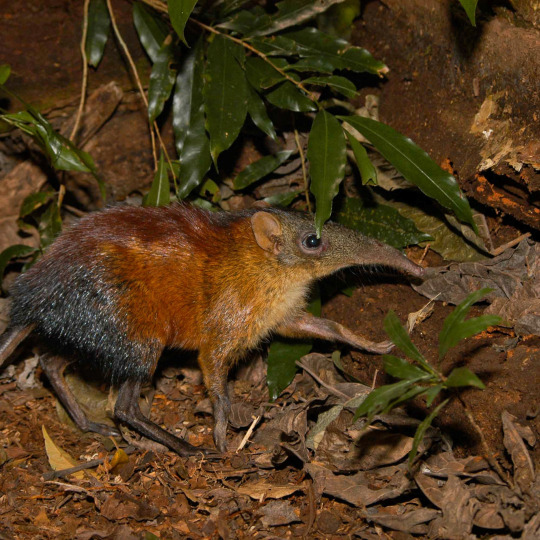
Sengi (elephant shrews (or better known as the get a look at the snout species))...is another insectivore that is more closely related to elephants than true shrews. they live in southern Africa and have relatively large brains for their size (a respectable 11 inches) (this is a black and rufous sengi)

Tenrec..omnivorous little mammal that lives in land, sea, underground, and in trees. there are many different subspecies of tenrec that can look like hedgehogs, opossums, rats, and shrews (this is one is a lowland streaked tenrec from madagascar)
#i was going to include binturongs but compared to all the other guys its much larger#So i decided to just keep the list about small weird mammals#These of course arent all the small mammals out there.. just the ones i can remember offhand#mammalia#long post#quoll#spotted-tail quoll#marsupials#tenrec#streaked tenrec#elephant shrew#sengi#solenodon#cuban solenodon#hyrax#numbat#mammals#biology#zoology#animal facts
9K notes
·
View notes
Text

Brehm's Tierleben. Written by Alfred Brehm. Illustration by Gustav Mützel. 1900 edition.
Internet Archive
114 notes
·
View notes
Text
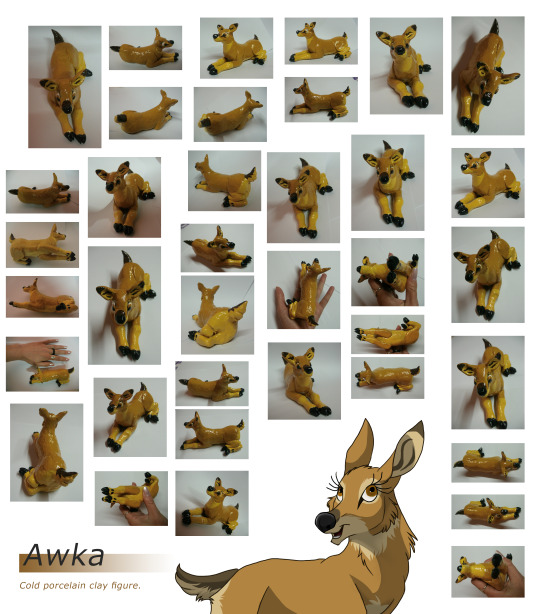

Awka, and Yucca&Capuli figurines (2019 both)
Cold porcelain modelings! To this day, the two of them are resting on a shelving, some two metres away from me right now.
Awka one was especially challenging, due to Deer Legs, but I do recall loving working on it, and I am still quite fond of both figures, for that very reason. I was going to make a Palqu one, but only made the early stages back then and didn't complete it, I might still have the unpainted base around haha. Maybe I should check how well he looks?
Anyway, something different. I almost didn't make Capuli to accompany Yucca back then, but then I realised it was then or never, due to his wee eeny size..
#Crafting#figurines#cold porcelain#awka#huemul#deer#Yucca#Solenodon#Cuban#Capuli#Hummingbird#BeeHummingbird#OCs#modeling#2019#Nothofagus-obliqua
10 notes
·
View notes
Text
The most scrungly animals LOOOOVE being endangered
2 notes
·
View notes
Text

i’m so overcome i just learned about an incredible new animal. it’s called a cuban solenodon it’s a weird shrew with venomous saliva. it was thought to be extinct from the 1890s until the 1970s. i love sneaky little animals evading naturalists and recovering from human ruination out of sight it’s so fucking powerful
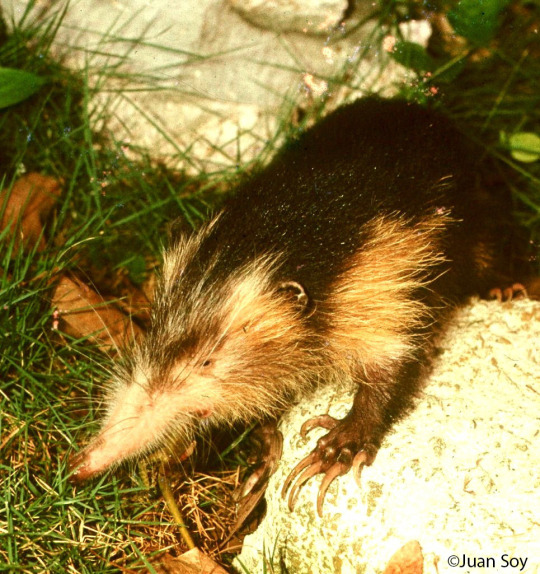
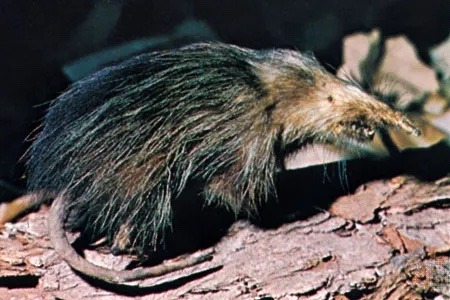
11 notes
·
View notes
Text

Cuban solenodon
By: New York Zoological Society
From: A History of Land Mammals in the Western Hemisphere
1913
#captivity#solenodon#eulipotyphlan#mammal#1913#1910s#New York Zoological Society#A History of Land Mammals in the Western Hemisphere
8 notes
·
View notes
Text
Ullante post
Name: Pinus
Kingdom: Eastern Empire
Class: Dromaeus
Species cross: Epicyon haydenii-Ambopteryx
Age: 3
Gender:pan cisgender roo
Size class: large
Weight class: bulky
+: loyal, funny, fun, generous, family roo
Neutral: sassy, casual, curious
-: blunt, rash, brutish
Strengths: jaws strong enough to crunch bones, wood, and shells. Endurance runner, can keep a steady jog for hours. Great sense of smell, can detect a drop of blood in a football field. Large frame=strength to carry and drag heavy loads. Swamp wise
Weaknesses: not very dextrous, oblivious, too willing to work hard instead of smart
Occupation: crabber(hunter/trapper of shellfish)
Likes->
Avus: his family, his neighbors, respectful to the fact that he's a dromaeus
Food: mama's cooking, shellfish, fish, fruit
Other: hunting alone, helping his brother with supply runs, going fishing with his father
Dislikes->
Avus: hightrees, thieves, who judge him for being s dromaeus
Food: overly sweet foods, poultry
Other: cold weather, armor, working the forge
Purchased traits: bronze skewer, fishing knife, and cleaver. Bag for tools. Game bag. Piebaldism
Voice claim: dunno, but definitely a deep white Cajun voice
Family->(all of the parents are in a polymary relationship, but they didn't know how that worked, so the first two got married then divorced to marry the other two in)
Coffea: adoptive mom, loves and respects her and her cooking very much: chef: Woodbanded Ratrec*-Eastern Whip-Poor-Will
Alnus: adoptive dad, loves and respects very much, worries for: fisher/river taxi: Chimpmunk-White Headed Vulture
Gristle: adoptive stepfather, loves and respects: trash collector: Brown Rat-Bluetailed Chatteraven*
Cinnamon: Adoptive stepmother, loves and respects very much: merchant: Virginia Opossum-Turkey Vulture
Aspirin: adopted brother, loves and looks up to, often helps on supply runs: surgeon-apothecary: Woodbanded Ratrec-White Headed Vulture
Tarot: adopted brother, loves, worries for with all this voodoo madness, especially when he read his future: "voodoo witch doctor"(seer and magician): Virginia Opossum-White Headed Vulture
Herb(aka Squeak): adopted younger sister, loves and is very protective of: student: Chimpmunk-Eastern Whip-Poor-Will
Nerium: adopted sister, loves very much, worries for: hunter/bronzesmith: Brown Rat-Turkey Vulture
Bleedweed: adopted sibling, loves very much: inventor/crabber: Virginia Opossum-Bluetailed Chatteraven*
Bombax(aka bomb): adopted-adopted brother, loves very much: crabber/trapper: Martenrat*-Pennant Winged Nightjar
Brahaea: adopted-adopted sister, loves and respects: hunter/rancher/crabber: Saltolestes*-Terror Chicken*
Other->
Rot: friend of the family, worries for: soldier: Cuban Solenodon-Hooded Pitohui
Tolra: likes, knows brahaea has a crush and teases bout it: weaver/jewler: Sifaka-Pigeon
Feldspar: once met in a fight, fears his size, respects his power: student/construction apprentice: Titan Bear*-Strongwing*
Tuna: fears, knows about his war fame from stories but only ever seen him once. Knows he hates him for being a dromaeus: Sergeant: chacma baboon-bearded vulture
Name: Arctas
Kingdom: none(travels waters round the globe
Class: Palaeus
Species cross: Arctodus-Palaeeudyptes Klekowskii
Age: 11
Gender: pan demihen(she/they)
Size class: enormous
Weight class: tank
+: wise, patient, steady, loyal, clever, accepting
Neutral: blunt, ambitious, sassy
-: stubborn, hardheaded, and rigid
Strengths: very good swimmer, strong enough to grapple with Tuna, wise in the ways of sailing and the ocean, good in cold climates, very good penmanship and writing skills
Weaknesses: not very fast, weak in hot climates, not very stealthy
Occupation: whaler captain
Likes->
Avus: her crew, hailstorm, young avus
Food: shark, whale, seal, stews using those ingredients, and potatoes
Other: writing, whaling, hanging with her crew, snow, swimming, sparring, thunderstorms
Dislikes->
Avus: palaeus, stingy, cowards, thieves
Food: beef, poultry, and fruits
Other: being too far inland, her crew being in danger, flying
Purchased traits: Whale bone necklace with shark teeth made from seal leather cord. Pet dog, Phoca. Sharkbite scar on front left paw, slash scar on front right arm, clawmarks on right haunch, sharkbite on left leg
Voice claim: Dunno. Definitely strong booming voice with somewhere between a New York and Russian accent
Family->
Her crew: loves, respects, regularly hangs out and works with, and worries for
Biological father: dead, never knew em: unknown: Arctodus-Haast Eagle
Biological mother: dead, never knew em: unknown: American Cheetah-Palaeeudyptes klekowskii
Other->
0 notes
Photo

Hispaniolan solenodon (Solenodon paradoxus)
Photo by Miguel A. Landestoy T.
#cuban solenodon#solenodon paradoxus#solenodon#solenodontidae#eulipotyphla#laurasiatheria#boreoeutheria#eutheria#mammalia#tetrapoda#vertebrata#chordata
229 notes
·
View notes
Photo

Cuban solenodon skeleton from the National Museum of Natural History in Washington DC. Solenodons belong to the order Eulipotyphla and are related to moles, shrews, and hedgehogs. Exceedingly rare to find alive in Cuba, it has been thought to be extinct in the past but has since been “rediscovered” multiple times.
#natural history#vulture culture#vc#mammal skull#mammal skeleton#animal bones#solenodon#cuban solenodon#cuban wildlife#smithsonian
146 notes
·
View notes
Photo
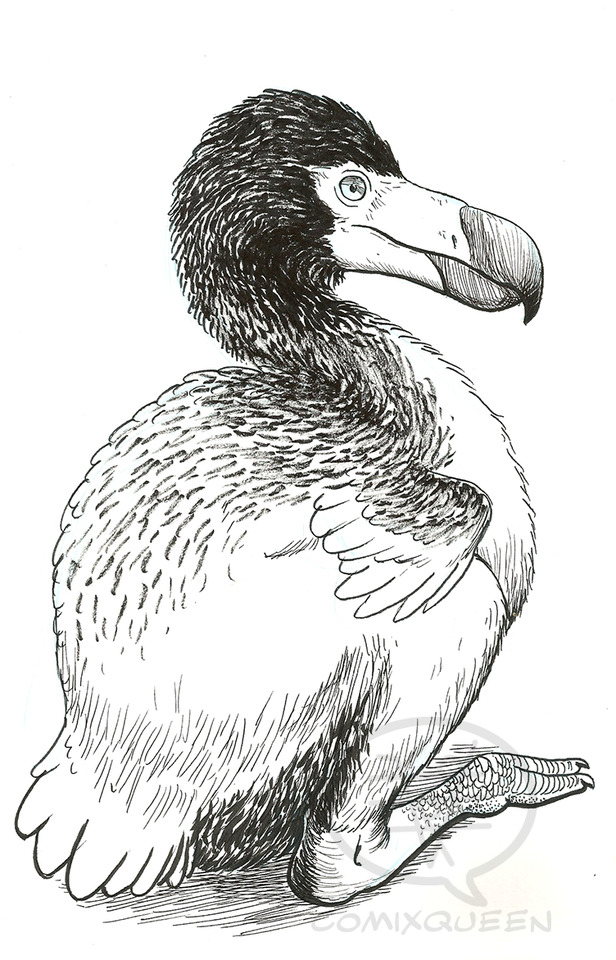



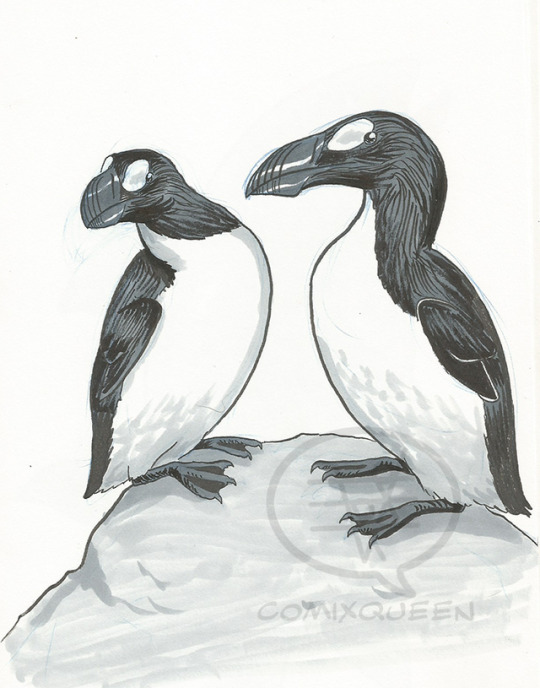
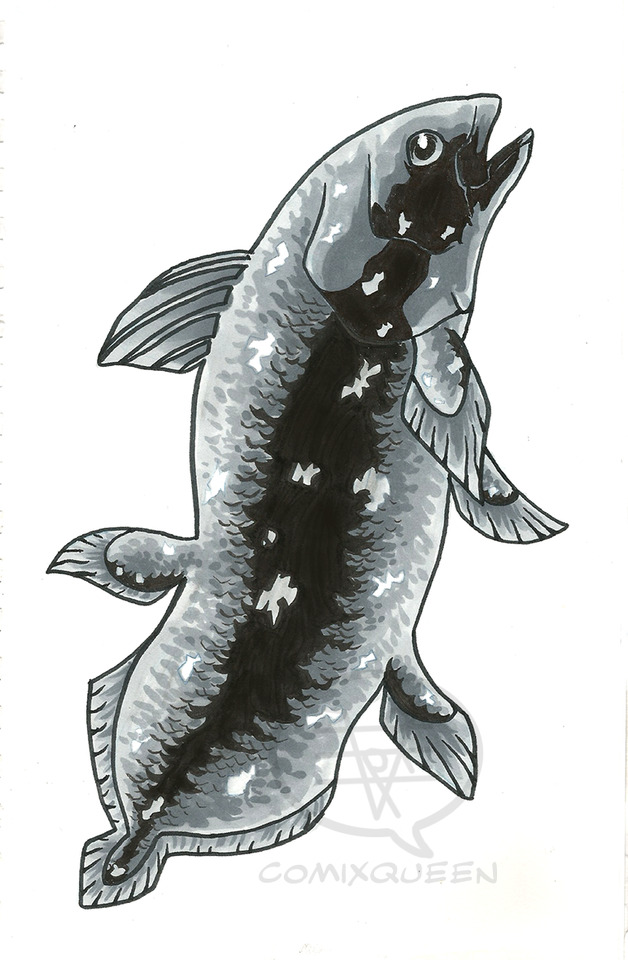



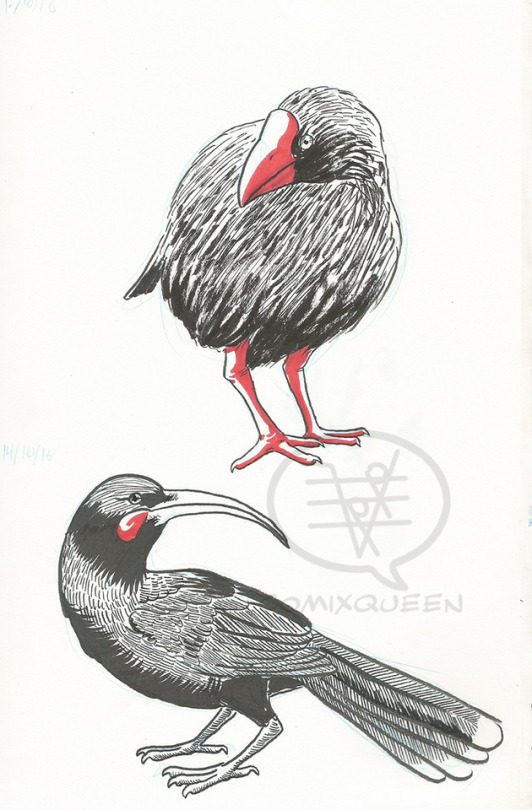
SO turns out I forgot to post my 2016 inktobers here? ;u;
I chose “recently extinct species” as a theme because I wanted to hurt myself I have a morbid love and fascination with these animals I will never see alive. After day 1 it became clear to me that I needed something to keep this project from becoming a sob-fest, so I decided to alternate between recently extinct and Lazarus taxa.
I didn’t finish, as you can see. It’s even obvious where I lost steam haha.
Species list under the cut:
Dodo (Raphus cucullatus) Extinct circa 1662
Cuban Solenodon (Solenodon cubanus) Declared extinct in 1970 but rediscovered in subsequent years.
Steller’s Sea Cow (Hydrodamalis gigas) Extinct since 1768, only 27 years after its discovery by Europeans.
New Caledonian Crested Gecko (Correlophus ciliatus) Thought to be extinct until it was rediscovered in 1994.
Great Auk (Pinguinus impennis) Extinct circa 1844 when the last breeding pair was killed on the island of Eldey.
West Indian Coelacanth (Latimeria chalumnae). Coelacanths were thought to have gone extinct in the Late Cretaceous, but were accidentally rediscovered in 1938.
Pig-footed Bandicoot (Chaeropus ecaudatus) Extinct sometime in the 1950s.
Laotian Rock Rat or Kha-nyou (Laonastes aenigmamus) Considered to be distinct from all living rodents, its closest relatives went extinct in the Miocene, 11 million years ago.
Quagga (Equus quagga quagga) The last captive specimen died in 1883.
Forest Owlet (Athene blewitti) Not seen after 1884 and considered extinct until it was rediscovered in 1997.
Laughing Owl (Sceloglaux albifaces) Extinct circa 1914.
Takahē (Porphyrio hochstetteri) Thought extinct in 1898, rediscovered in 1948.
Huia (Heteralocha acutirostris) Depicted here is a female. Last official, confirmed sighting was made December 28th, 1907.
#art#inktober#inktober 2016#inktober2016#extinct animals#extinct species#lazarus taxa#lazarus species#dodo#solenodon#cuban solenodon#steller's sea cow#crested gecko#new caledonian crested gecko#great auk#coelacanth#west indian coelacanth#pig-footed bandicoot#laotian rock rat#kha-nyou#quagga#forest owlet#laughing owl#takahe#takahē#huia
297 notes
·
View notes
Note
Will El Jefe be a snow leopard or liger (half-lion & half-tiger)? Just let you know that He would be great to fight against Wander from WOY in my AU story... -🪕🦋
I’m diving WAAAAY back into my inbox and answering some stuff I had skipped or didn’t see lol this is from like a year ago RIP I’m going to pass over the AU thing for this tho.
I always believed El Jefe would have done better as a leopard or something. But I saw a post on here recently suggesting him being a cow because of a funny joke related to Castro which he’s based on and I thought that was genius LOL
It also made me rethink his potentials as different animals. If we assume he’s Cuban or wanna roll with that trope, we can make him a notable animal from Cuba. I think hutia are pretty cool??
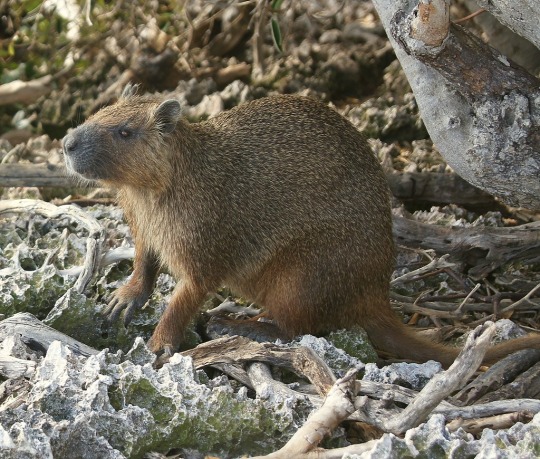
But then I found Solenodon which are shrew-like critters that have VENOMOUS SALIVA??

Like I get that they picked a scary tiger for him cause predators are more inherently badass and intimidating upon first glance. But it’s completely feasible to make one of these guys look scary. I think if I get around to designing El Jefe I’ll go Solenodon route just to prove it. Good artists can make anything badass.
Literally the only fault is he might resemble Toothpick too much. But that’s a thought project for another day…
10 notes
·
View notes
Photo

Island Weirdness #47 — Megalocnus rodens
Just 21km south of the Bahamas (13 miles), Cuba is the biggest island in the Caribbean and has a complex geological history. It originated as part of a volcanic island arc in the Late Cretaceous and during its existence in the Cenozoic it was colonized by a richer variety of mammals than the Bahamas ever had, including rodents, the enigmatic solenodons and nesophontes, and ground sloths.
The Caribbean ground sloths were all part of the megalonychid lineage — which eventually reached North America and produced giants — and they arrived on Cuba by the early Miocene, about 20 million years ago.
Megalocnus rodens lived during the Late Pleistocene and Holocene, between about 125,000 and 5000 years ago. It had unusually rodent-like front teeth, and while it was dwarfed compared to its mainland relatives it was actually one of the largest of the Cuban ground sloths — close to the size of a modern black bear, about 80cm tall at the shoulder (2'5").

Subfossil remains show that Megalocnus survived well into the Holocene, and there's been speculation that it may even have still been around in the highland forests as late as the time of European colonization in the 1500s.
However, radiocarbon dating of remains has given no dates younger than about 5000-4000 years ago, about 1000 years after the earliest arrival of humans in Cuba.
#science illustration#island weirdness 2019#paleontology#paleoart#palaeoblr#megalocnus#megalonychidae#pilosa#sloth#folivora#xenarthra#mammal#art#cuba#caribbean#insular dwarfism#holocene extinction#island weirdness 2: endemic boogaloo
137 notes
·
View notes
Photo

Endangered Inktober - Hispaniolan Solenodon by Ciameth
Day 18 - Hispaniolan Solenodon, Solenodon paradoxus
IUCN Status: Endangered
Solenodons are a unique group of venomous, nocturnal, insectivorous mammals. They diverged from other modern mammal lineages around 73 million years ago, existed alongside dinosaurs, and survived the K-T extinction event at the end of the Cretaceous. Today, two species of Solenodon remain - the Hispaniolan Solenodon, found only on Hispaniola, and the Cuban Solenodon, found only on Cuba. Both are endangered.
The Hispaniolan Solenodon has a long, flexible snout and an incredible sense of smell. They have terrible eyesight and hunt through scent and feel. Unique among mammals, the Solenodons have venomous salivary glands. The venom is injected through grooves on the incisors and used to incapacitate prey.
Unfortunately, the Solenodons are not able to defend themselves against introduced mammalian predators like feral dogs, outdoor cats, rats, and mongooses. They are also trapped for human consumption due to food shortages. The Hispaniolan Solenodon needs more protected habitat, so it has space to thrive away from human habitation, and invasive species on the island need to be eradicated or controlled.
7 notes
·
View notes
Photo

“Lazarus species” (started 2021, casually finished in 2022)
Hi again! Still alive.
Random dissappearance was due to needing to replace the entire (wood-tiled) roof of my house... I’m absolutely broken, had to ask family and even a friend for money, but the deal is done at least. And just in time as it’s started raining and it’s gonna remain that way for at least a week (thankfully!!! the drought has been severe in here lately, and the forest fires all over the country have been brutal). I will have to budget very hard in the upcoming months, and feeling exhausted, but also relieved the roof is done with.
So yeah! This blog exists mostly to archieve old art, but have some new art this time!
Lazarus species.... aka, species that were once thought extinct, but were later found to still subsist. Names in the tags, and probably to be edited later and added to the body of the post as well.
These are just casual doodles, that I sometimes do as warmup. They’re not the best and I can see alot of things I could fix... but doodles be doodles!
I will be sharing some more old art later :>
#Lazarus species#Takahe#Cuban solenodon#Chacoan peccary#coelacanth#New Guinean Big-eared bat#Nightparrot#Pombero ant#Lord Howe Island Stick Insect#Laotian rock rat#Terror skink#Biodiversity#doodles
111 notes
·
View notes
Link
Solenodons (meaning "slotted-tooth") are venomous, nocturnal, burrowing, insectivorous mammals belonging to the family Solenodontidae. The two living solenodon species are the Cuban solenodon (Solenodon cubanus), and the Hispaniolan solenodon (Solenodon paradoxus). Both species are classified as "Endangered" due to habitat destruction and predation by non-native cats, dogs and mongooses, introduced by humans to the solenodons' home islands to control snakes and rodents.
3 notes
·
View notes
Photo

Save the polar bears, of course … but it’s the solenodons we really need to worry about | The Guardian
Solenodons are some of Earth’s strangest creatures. Venomous, nocturnal and insectivorous, they secrete toxins through their front teeth – an unusual habit for a mammal. More to the point, the planet’s two remaining species – the Cuban and the Hispaniolan solenodon, both highly endangered – have endured, virtually unchanged, for the past 76 million years. Other related species have become extinct.
And that makes solenodons very important, according to Professor Sam Turvey, of the Zoological Society of London. “They are the last fruits on an entire branch of the tree of evolution,” said Turvey, who was last month awarded one of the most prestigious awards in zoology, the Linnean medal, for his work on evolution and human impacts on wildlife. “There are no close counterparts to solenodons left on Earth, yet they have been on the planet since the time of the dinosaurs.”
Solenodons have been brought close to extinction by the mongoose, the carnivore introduced to their native islands to kill snakes and rodents. They are classic examples of an “Edge” – evolutionary distinct and globally endangered – species. This means they have no close relatives and represent our last chances to preserve entire branches or trunks of the evolutionary tree.
Other examples include the critically endangered vaquita, a species of porpoise from the Gulf of California, and the Sumatran rhino. “A lot of attention is paid to other threatened rhino species,” said Turvey, “but the Sumatran, which is down to only a few dozen survivors, is the only woolly rhino left on the planet. It is special.”
These animals stand in contrast with other threatened species which have close relatives that fill similar ecological niches. The polar bear, for example, is closely related to the grizzly. Should the former die out, the latter could provide a fair amount of genetic substitution, say scientists. By contrast, there is no species that could do the same for solenodons.
Another example is provided by the gibbons of Asia. Most species are now endangered, with some, such as the Hainan gibbon, facing imminent extinction. Yet gibbons were once widespread and common. “In the tombs of ancient Chinese emperors,” said Turvey, “we have discovered bones of gibbons, kept as high-status pets, from species previously unknown to science. Over millennia, we have lost countless species, and entire genera, of gibbons in Asia.”
26 notes
·
View notes